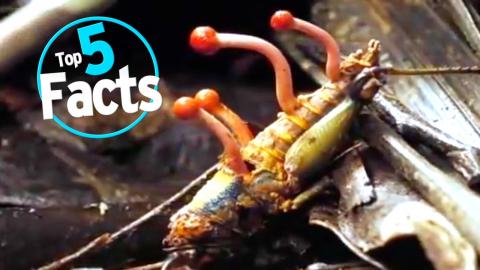Top 5 Facts about Mushrooms

They're more than just a pizza topping. Join http://www.WatchMojo.com for Top 5 Facts. In today's installment we're counting down our picks for the 5 most interesting and ground-breaking facts about mushrooms. No, our focus will not be magic mushrooms, but instead the biological aspects of our fungal friends. If tripping balls is a topic of which you'd like to be enlightened, we have just the thing for you to check out, but today we'll be focusing strictly on science. See WatchMojo's episode of Top 5 Facts about hallucinogens here: https://youtu.be/l4ZPP5gZAac
Special thanks to our user Daniel Fong for submitting the idea at WatchMojo.comsuggest
#5: The Largest Known Organism on Earth is a Fungi
Take that blue whales! Armillaria gallica, or honey mushroom as it’s called on the streets, has achieved this prestigious accolade. Don’t go picturing some monstrous mushroom towering above the forest; this guy is spread out wide. Covering over 3.7 square miles in eastern Oregon and weighing an estimated 7,500 tons or more, its mass is mostly made up of rhizomorphs, fungus’s underground root-like system. It’s also killed thousands of trees which may or may not be considered a good thing depending on how you look at it. The circle of life in the forest requires fungi to rot organisms and recycle them back into the soil, and this colossal machine does so at an outstanding rate. A representative from the Department of Natural Resources called it the baddest fungus on the block. It didn’t just spring up overnight though: through genetic testing, scientists have estimated its age at between 1900 and 8650 years old.
#4: Fungi Inherited the Earth
Millions of years before green and orange-capped mushrooms gave Mario and Luigi a new lease on life, dinosaurs roamed the earth and sea. The working theory for these massive reptiles extinction involved a meteor, a sky-sized cloud of dust, and no sunlight for an extended period of time. This resulted in the death of plants and animals alike. Luckily for fungi, they don’t photosynthesize, so they thrived in this dark environment. To paraphrase Matthew 5:5, and quote mycologist Paul Stamets, this is when fungi inherited the earth. While obtaining energy by consuming dead plants and animals certainly isn’t sexy, it proved useful for mushrooms, as well as the organisms that paired with them. More recently, scientists discovered a handful of mushroom varieties that seem to feed off of radiation, so who knows, if someday humanity endures a nuclear winter, maybe fungus will 1-Up the earth yet again.
#3: Mushrooms Eat Diesel
Oyster Mushrooms may look like something growing on the side of a fairy tale witch’s shack, but they actually have a sort of magic of their own. Paul Stamets, who is basically the Lebron James of mycology, has carried out tests demonstrating the mushroom’s ability to decontaminate soil soaked with diesel. Over time, Stamets has refined the technique and actually discovered strains of the mushroom that are tolerant to salt water, allowing him to create what he calls a Mycoboom, a sort of floating mushroom garden that can be deployed over maritime oil spills. One can only imagine how the BP oil spill might have been different with this technology. Scientists such as Stamets have gone on record stating that mycology is greatly underfunded, and that fungi such as the Oyster Mushroom may have large amounts of tangible benefits to offer us if given the proper attention. For instance, in 2015, a team from the University of California Riverside discovered that material from portobella mushrooms can replace and improve upon the graphite used in lithium-ion batteries.
#2: Cordyceps Zombify Insects
If you’re having a rough day, try and keep this in mind… at least mushrooms haven’t tried to eat you alive. The Ophiocordyceps sinensis, or caterpillar fungus, isn’t known for patience, or respecting personal space for that matter, as it germinates in insects while they’re still alive. Other cordycep varieties target ants, wasps, grasshoppers– you name it. After these unsuspecting prey are attacked, the fungi stays in the host, sometimes for months on end, before killing it and rupturing through the poor thing’s head. The caterpillar fungus has a long history in Chinese folk medicine and has been used as an aphrodisiac, cure for cancer, and just about everything in between. A couple pounds of ophiocordyceps sinensis has been known to fetch the equivalent of $35,000 in China, so at that price, it had better cure everything!
#1: Life on Earth Would Disappear Without Mushrooms
We’ve already explored mushrooms role as grim reaper, psychedelic drug, and delicious pizza topping. It is also key for the very survival of life on our planet. Fungi serves the role of nature’s recycler, cleaning up and decomposing dead (and sometimes still alive) plants and animals. Without this service, earth would very soon be covered in layers of debris and no longer be able to produce new life; without carbon and other elements being recycled into the soil, plants would eventually stop growing. Scientists point to the forests around Chernobyl, where high levels of radioactive contamination have inhibited fungal activity so much, that fallen trees and leaves hardly decompose at all. Research also suggests that fungi were the first organisms to leave the ocean and live on land, and played a crucial role in allowing plants to do the same. That the circle of life we take for granted today would be nothing without mushrooms.
So do you have a newfound respect for fungi? Are you an aspiring rockstar mycologist? For more recyclable Top 10s and parasitic Top 5s, be sure to subscribe to WatchMojo.com.